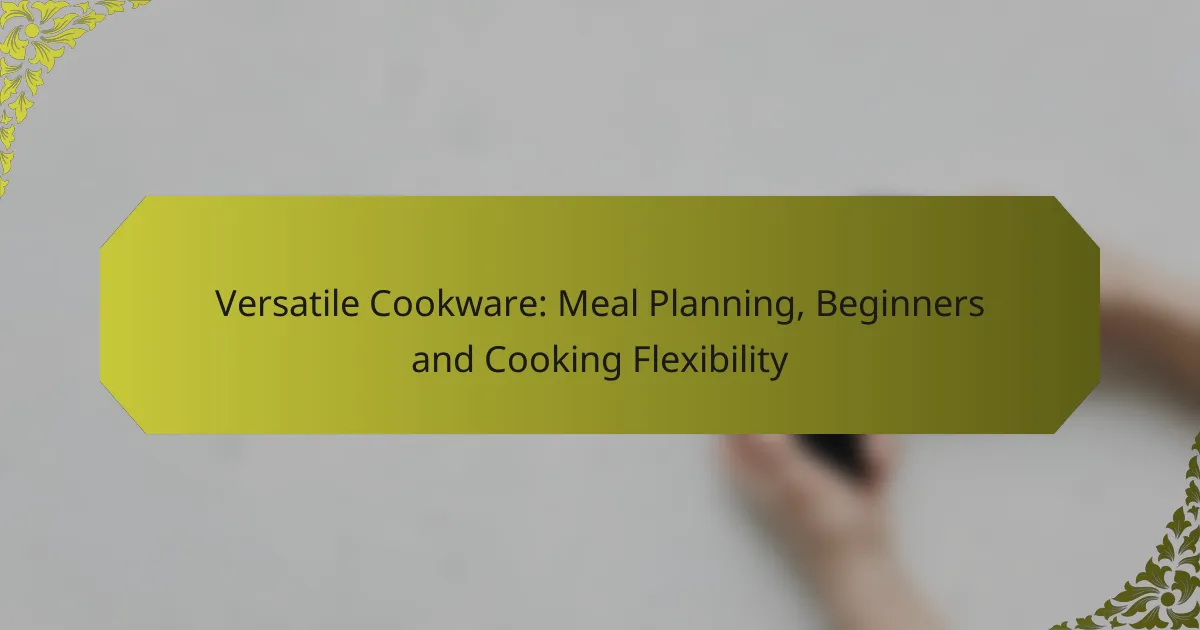Versatile cookware is essential for efficient meal planning, especially for beginners looking to expand their culinary skills. Items like cast iron skillets, stainless steel pots, and multi-cookers can accommodate a variety of cooking methods, making them invaluable in the kitchen. By investing in multifunctional pieces, home cooks can save money, optimize space, and enjoy greater flexibility in their cooking endeavors.
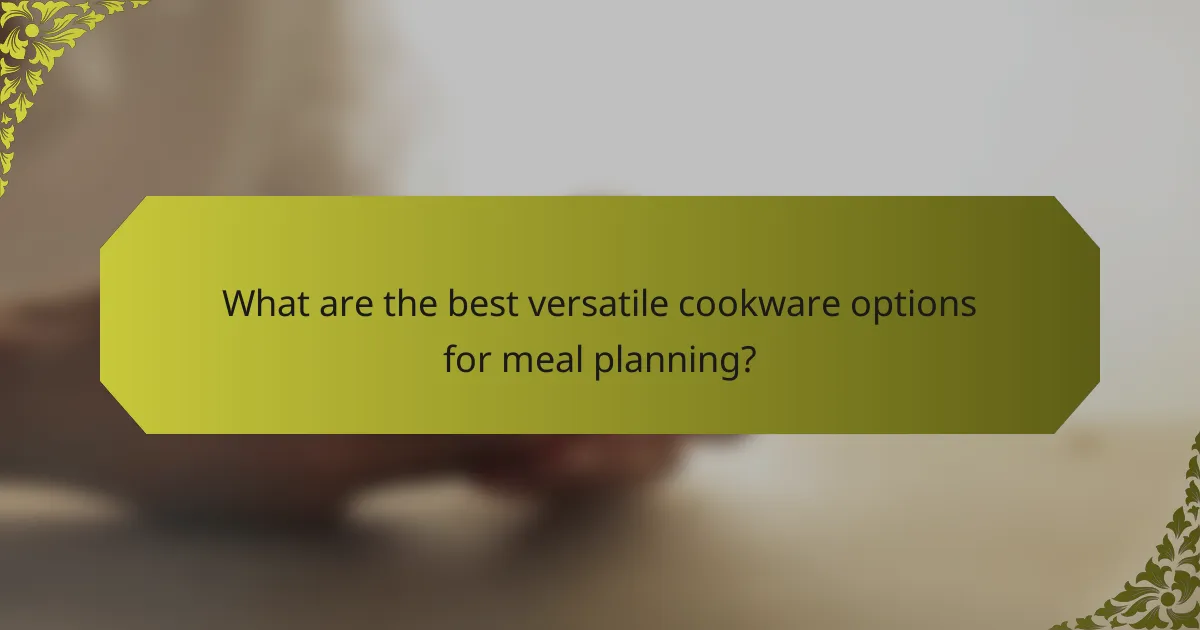
What are the best versatile cookware options for meal planning?
The best versatile cookware options for meal planning include cast iron skillets, stainless steel pots, non-stick frying pans, multi-cookers like Instant Pot, and enamel Dutch ovens. These items can handle a variety of cooking methods and recipes, making them essential for efficient meal preparation.
Cast iron skillets
Cast iron skillets are renowned for their heat retention and even cooking. They can be used on the stovetop or in the oven, making them ideal for searing, baking, and frying. Regular seasoning helps maintain their non-stick properties and prevents rust.
When using cast iron, avoid cooking acidic foods like tomatoes for prolonged periods, as they can strip the seasoning. Instead, focus on dishes like cornbread, frittatas, or skillet pizzas to maximize their versatility.
Stainless steel pots
Stainless steel pots are durable and resistant to staining and rust, making them a staple in many kitchens. They are excellent for boiling, simmering, and steaming, and they do not react with acidic or alkaline foods.
For best results, preheat the pot before adding oil or food to prevent sticking. Use these pots for soups, stews, and pasta dishes, ensuring you have a range of sizes for different meal portions.
Non-stick frying pans
Non-stick frying pans are perfect for low-fat cooking and easy cleanup. They require less oil for cooking, which can be beneficial for health-conscious meal planning. These pans are ideal for eggs, pancakes, and delicate fish.
However, avoid using metal utensils to prevent scratching the surface. Regularly inspect the non-stick coating for wear and replace pans as needed to maintain cooking performance.
Multi-cookers like Instant Pot
Multi-cookers, such as the Instant Pot, combine several cooking functions into one appliance, including pressure cooking, slow cooking, and sautéing. This versatility allows for quick meal preparation and the ability to cook a variety of dishes in one pot.
Utilize the pressure cooking feature for fast meals like stews or rice, and the slow cooking option for tenderizing meats. Familiarize yourself with the specific settings to maximize efficiency and avoid overcooking.
Enamel Dutch ovens
Enamel Dutch ovens are excellent for slow-cooking, braising, and baking. Their heavy construction ensures even heat distribution, making them suitable for a range of recipes from soups to casseroles. The enamel coating prevents rust and makes cleaning easier.
When using a Dutch oven, avoid high heat to prevent chipping the enamel. These pots are perfect for hearty dishes like coq au vin or baked bread, providing both functionality and aesthetic appeal for serving.
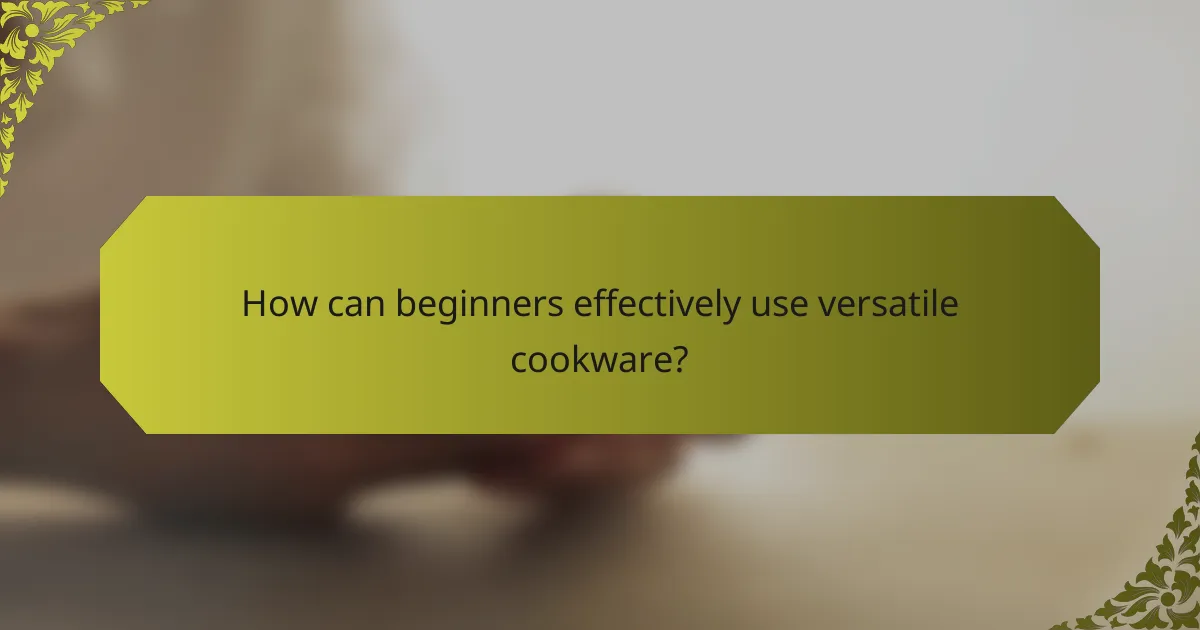
How can beginners effectively use versatile cookware?
Beginners can effectively use versatile cookware by starting with simple recipes and gradually expanding their skills. This approach allows them to become comfortable with different cooking methods while maximizing the functionality of their cookware.
Start with simple recipes
Begin with straightforward recipes that require minimal ingredients and steps. Dishes like stir-fries, omelets, or pasta can be prepared quickly and allow for experimentation with flavors. These recipes often require just one or two versatile cookware pieces, such as a skillet or pot.
As you gain confidence, try to incorporate more complex recipes that utilize the same cookware. This helps reinforce your skills while keeping the learning curve manageable.
Learn basic cooking techniques
Familiarize yourself with fundamental cooking techniques such as sautéing, boiling, and baking. Understanding these methods will enable you to use your cookware effectively for a variety of dishes. For instance, knowing how to sauté vegetables can enhance many recipes, from stir-fries to soups.
Consider watching instructional videos or attending local cooking classes to learn these techniques hands-on. Practice will help solidify your understanding and improve your cooking flexibility.
Utilize meal prep strategies
Meal prepping can save time and reduce stress during the week. Start by planning your meals and preparing ingredients in advance, such as chopping vegetables or marinating proteins. This makes it easier to cook meals quickly using your versatile cookware.
Consider batch cooking larger portions and storing them in the refrigerator or freezer. This approach not only maximizes the use of your cookware but also ensures you have healthy meals ready to go, reducing the temptation to order takeout.

What are the benefits of using versatile cookware?
Versatile cookware offers numerous advantages, including cost savings, efficient use of space, and enhanced cooking flexibility. By investing in a few multifunctional pieces, home cooks can streamline meal preparation and adapt to various cooking methods.
Cost-effectiveness
Using versatile cookware can significantly reduce your kitchen expenses. Instead of purchasing multiple specialized pots and pans, a few high-quality, multifunctional items can handle a range of cooking tasks, from frying to baking.
For example, a cast iron skillet can be used on the stovetop and in the oven, eliminating the need for separate frying pans and baking dishes. This approach not only saves money but also reduces the frequency of replacements, as durable cookware tends to last longer.
Space-saving design
Versatile cookware is designed to maximize kitchen space, making it ideal for small kitchens or limited storage areas. Items that serve multiple purposes can often be stacked or nested, minimizing clutter.
For instance, a Dutch oven can function as a pot for soups, a baking dish for casseroles, or even a serving dish. By consolidating your cookware collection, you can free up valuable cabinet space for other essentials.
Increased cooking flexibility
With versatile cookware, home cooks can easily adapt to different recipes and cooking techniques. This flexibility allows for experimentation and creativity in the kitchen, making meal preparation more enjoyable.
For example, a multi-cooker can pressure cook, slow cook, sauté, and steam, enabling you to prepare a variety of dishes with one appliance. This adaptability is particularly beneficial for meal planning, as it allows for quick adjustments based on available ingredients or dietary preferences.
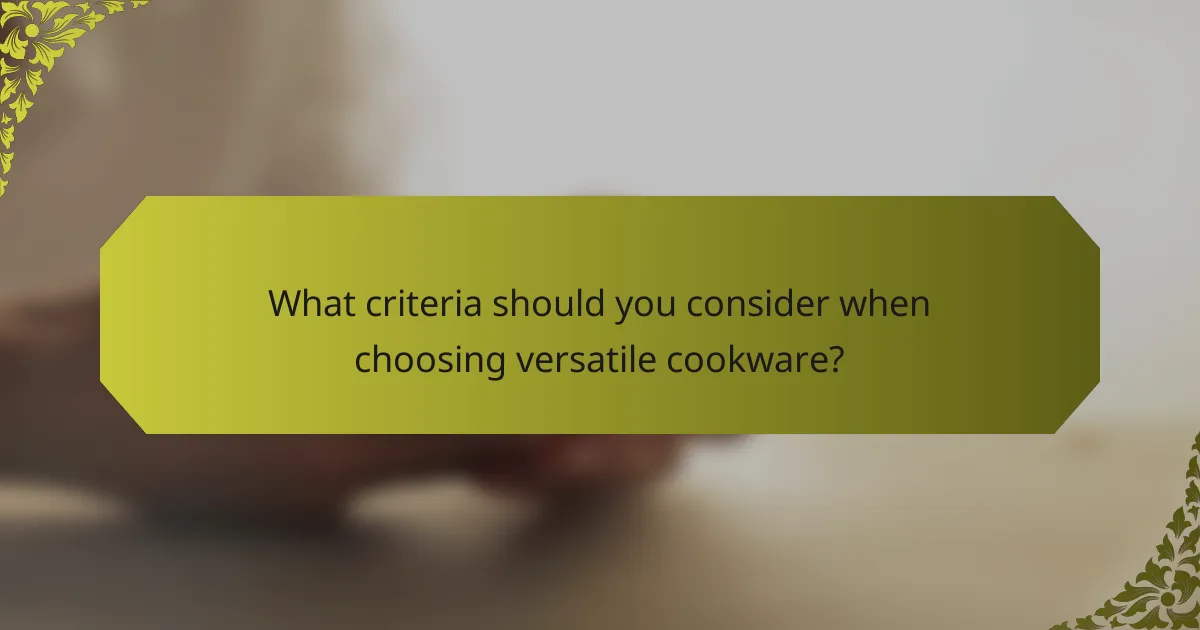
What criteria should you consider when choosing versatile cookware?
When selecting versatile cookware, focus on material durability, heat conductivity, and ease of cleaning. These factors significantly influence cooking performance, longevity, and maintenance, ensuring you get the most out of your kitchen tools.
Material durability
Material durability is crucial for versatile cookware as it determines how well the cookware withstands wear and tear. Common materials include stainless steel, cast iron, and non-stick coatings, each offering different levels of durability. For instance, cast iron can last a lifetime with proper care, while non-stick surfaces may require more frequent replacement.
When choosing cookware, consider how often you cook and the types of dishes you prepare. If you frequently use high heat or abrasive utensils, opt for more durable materials like stainless steel or cast iron to avoid damage.
Heat conductivity
Heat conductivity affects how evenly and quickly your cookware heats up. Materials like copper and aluminum are excellent conductors, providing rapid and uniform heat distribution, which is ideal for precise cooking techniques. In contrast, materials like cast iron heat slowly but retain heat well, making them suitable for slow cooking.
For versatile cooking, consider a combination of materials. For example, a stainless steel pot with an aluminum core can offer both durability and excellent heat conductivity, allowing for a range of cooking methods.
Ease of cleaning
Ease of cleaning is an important consideration for versatile cookware, as it impacts your overall cooking experience. Non-stick surfaces are easy to clean but may require special utensils to avoid scratches. Stainless steel and cast iron can be more challenging but often provide better durability and cooking performance.
To simplify cleaning, look for cookware with smooth surfaces and minimal crevices. Additionally, consider whether the cookware is dishwasher safe, which can save time and effort in your kitchen routine.
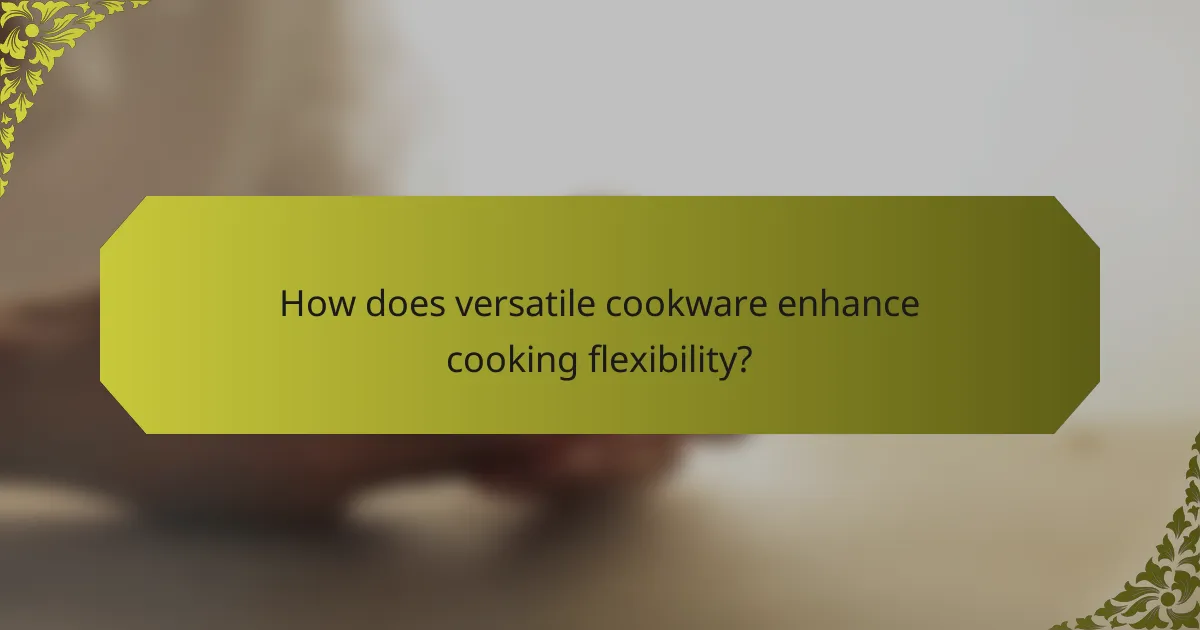
How does versatile cookware enhance cooking flexibility?
Versatile cookware enhances cooking flexibility by allowing users to prepare a wide range of dishes using different techniques and ingredients. This adaptability makes it easier for home cooks to experiment and create meals without needing specialized equipment.
Supports various cooking methods
Versatile cookware can handle multiple cooking methods such as sautéing, boiling, baking, and steaming. For instance, a cast iron skillet can be used on the stovetop for frying and then transferred to the oven for baking. This multi-functionality reduces the need for numerous pots and pans, saving both space and time.
When choosing cookware, consider materials that conduct heat evenly, like stainless steel or cast iron, which can enhance your cooking results across different methods. Avoid non-stick options for high-heat cooking, as they may degrade and release harmful substances.
Adapts to different recipes
Versatile cookware is designed to accommodate a variety of recipes, from soups to casseroles. A Dutch oven, for example, can be used for slow-cooking stews or baking bread, making it a valuable addition to any kitchen. This adaptability allows cooks to easily switch between cuisines and meal types without needing to invest in specialized tools.
To maximize the use of your cookware, familiarize yourself with its capabilities and limitations. Experiment with different recipes to discover how your cookware can be utilized in unexpected ways, enhancing your culinary repertoire.
Facilitates batch cooking
Batch cooking is simplified with versatile cookware, as larger pots and pans can accommodate multiple servings at once. For example, a large stockpot can be used to prepare soups or sauces in bulk, which can then be portioned and stored for later use. This approach not only saves time but also reduces food waste.
When batch cooking, ensure that your cookware is large enough to handle the volume of food you plan to prepare. Consider using airtight containers for storage to keep meals fresh, and label them with dates to track their shelf life. Aim to use cooked meals within a few days if refrigerated, or freeze them for longer preservation.
